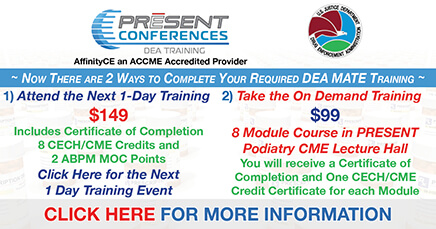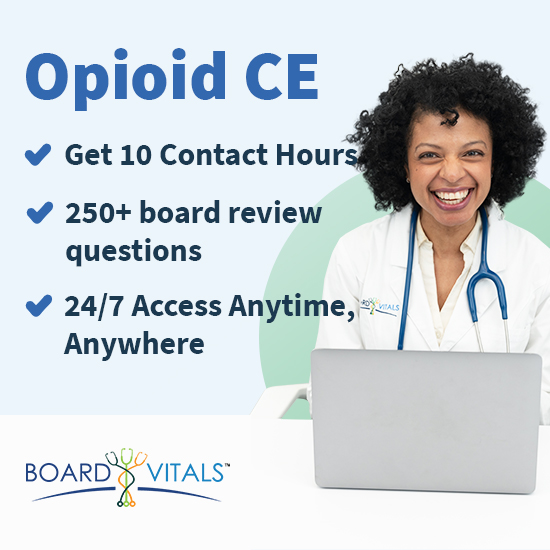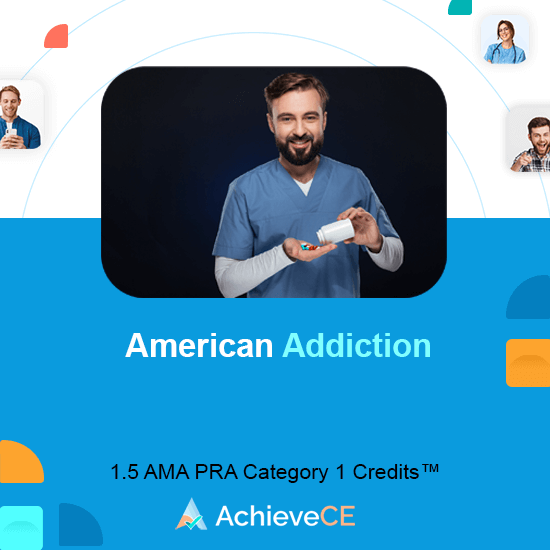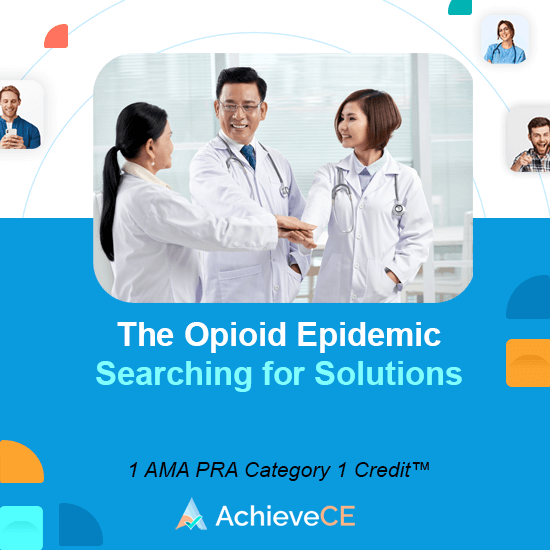Opioid CME
1 - 4 of 4 results
-
PRESENT DEA Mate Training – Complete Your Required Training
All DEA-registered practitioners have training requirements due at DEA registration renewal. With the enactment of the Consolidated Appropriations Act of 2023, the DEA now requires you to complete a one-time, eight-hour training requirement on the treatment and management of patients with opioid substance use disorders. PRESENT offers On-Demand Lectures Modules to complete your DEA CME requirements. Required for all renewals and new DEA registrations, this program was developed and accredited by AffinityCE, an ACCME Accredited and DEA-Qualified Provider.
See full details chevron_right- Cost: $199
- Credit hours: 8
-
BoardVitals Opioid CME Board Review
The BoardVitals Opioid CME Review offers clinicians 10 AMA PRA Category 1 CreditsTM and over 250 Opioid board review questions for free. The questions cover key topics including prescribing opioids and other controlled substances, pain management and palliative care, and substance use disorders. This question bank will assist clinicians meet their State CME requirements.
The BoardVitals Addiction Medicine CME Review also features:
- Free CME Credits
- Quick and Convenient CME
- Computer, phone, and tablet access
- Constantly updated up-to-date questions
- Questions that are targeted specifically to the exam
- Online CME tracker
- 100% Pass Guarantee
- Statistical comparison to other Addiction Medicine test-takers (Nationally)
After completing this activity, you should be able to:
- Identify the most commonly abused substances
- Recognize the most common indicators and symptoms of substance abuse and pain medicine dependency
- Describe the underlying pathophysiology of disease and basic science knowledge
- Formulate treatment for chronic pain management and substance abuse
Target Audience: Clinicians who deal with opioid prescribing and patients dealing with substance abuse and pain management
See full details chevron_right- Cost: $39
- Credit hours: 10
- CME credits awarded by: BoardVitals
- Format: On-Demand Online
- Material last updated: Continuously Updated
-
AchieveCE American Addiction
Every 7 minutes in our country, a person dies from a drug overdose, while a child is also born approximately every 30 minutes dependent on opioids. How do we as healthcare professionals offer non-stigmatic patient care and contribute to the progress of society in the right direction? Substance use disorder (addiction) is likened to an iceberg or a weed, in that the issues underneath the surface are typically even more complicated than what is viewed from the surface. Addiction spans hundreds of substances of abuse highlighted by stimulants (cocaine and methamphetamine), cannabis (plant, synthetics, and extracts), and opioids (heroin, fentanyl, and carfentanyl). As one can recall with the substance of ethyl alcohol (i.e. beer, wine, and hard liquor), a substance may never actually chemically change, yet can move across legal classifications of substances, leaving all healthcare professionals in need of knowledge on all substances of abuse. Opioid use disorder (opioid addiction) is combated with the medication-assisted treatments (MAT) of naltrexone, methadone, and buprenorphine, while opioid overdose respiratory depression is reversed with naloxone. Over the course of this activity, we will aim for “higher” education on all of these dynamic aspects. Unlike opioids, this activity is sure to open your eyes and possibly even elevate your blood pressure and/or heart rate!!!
See full details chevron_right- Cost: $16
- Credit hours: 1.5
- CME credits awarded by: 1 AMA PRA Category 1 Credit™ by Continuing Education Company, Inc. and AchieveCE, ACPE, AGD PACE, and ANCC.
- Format: Online Video
- Material last updated: 03/15/2025
- Expiration of CME credit: 03/15/2028
-
AchieveCE The Opioid Epidemic: Searching for Solutions Webcast
According to the 2015 National Survey on Drug Use and Health, approximately 3.8 million people (1.4% of those ages 12 or older) reported misusing prescription pain relievers, while another 329,000 people reported using heroin. Within the same year, 52,404 lethal overdoses took place, making drug overdose the leading cause of accidental death within the United States. Stancliff et al estimated that as of 2012, approximately 80% of people dependent on heroin or prescription opioids were not engaged in any treatment and many in treatment do not use the most effective medication-assisted treatments available to them.
Despite recent increased awareness of opioid use disorder (OUD) and efforts to improve access to care, several barriers to treatment still exist, including financial, geographic, regulatory, and social. In 2012, only 2.2% of physicians in the United States obtained waivers to prescribe buprenorphine for the treatment of OUD. Of those who received waivers, 41.6% were psychiatrists. This may be perceived as a potential barrier to OUD treatment as patients are often resistant to referrals to psychiatric and/or addiction clinics given the stigmas commonly surrounding addiction and mental health. Furthermore, physicians with waivers were found to practice primarily in urban settings, leaving a large portion of the rural population without access to buprenorphine treatment.
With all this in mind, education is needed in regards to current and emerging treatment options for OUD available to multiple patient populations. Also, with the deaths due to drug overdoses still elevated, education on how to recognize and reverse an opioid overdose is needed.
This presentation will address the above needs by discussing the science behind opioid use disorder as well as reflect upon current statistics associated with its impact on the United States. During the discussion, opioid overdose risks will be discussed and participants will be able to practice recognizing key symptoms of an overdose situation. Steps of using naloxone will be discussed and connected to how to appropriately seek out treatment for maintenance of opioid use disorder. Finally, new buprenorphine products and the potential role of naltrexone will be applied to this stigmatized population.
See full details chevron_right- Cost: $15
- Credit hours: 1
- CME credits awarded by: Continuing Education Company, Inc. and AchieveCE, ACPE, AGD PACE, and ANCC
- Format: Online Video
- Material last updated: 07/31/2024
- Expiration of CME credit: 07/31/2027




